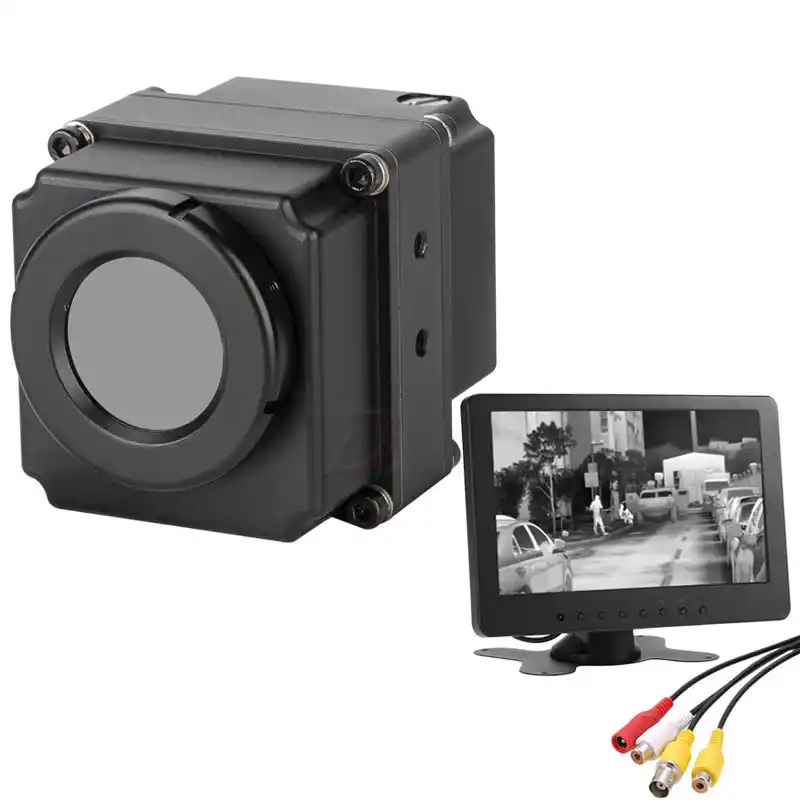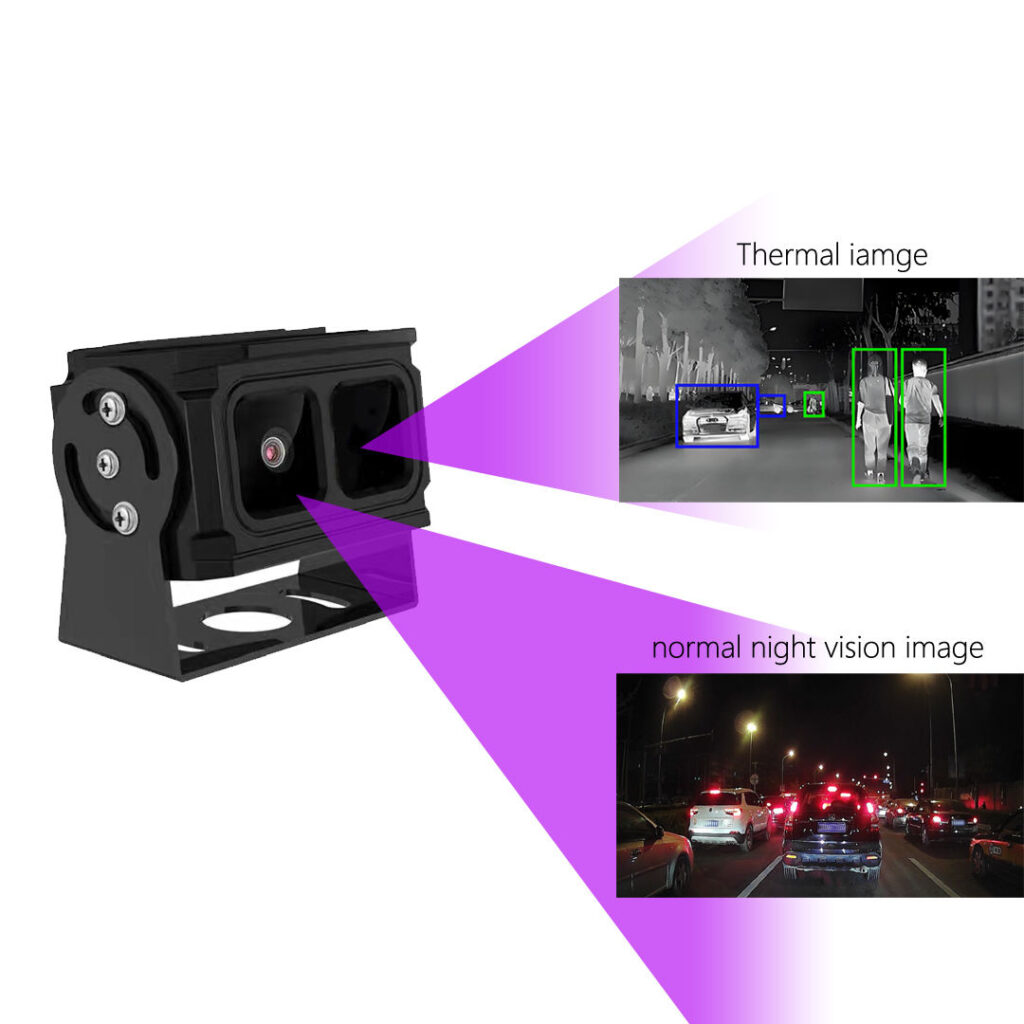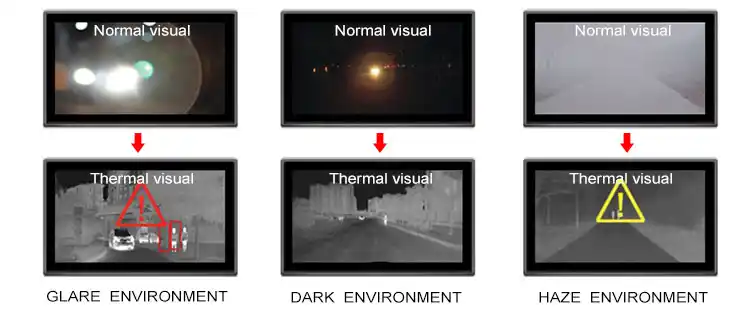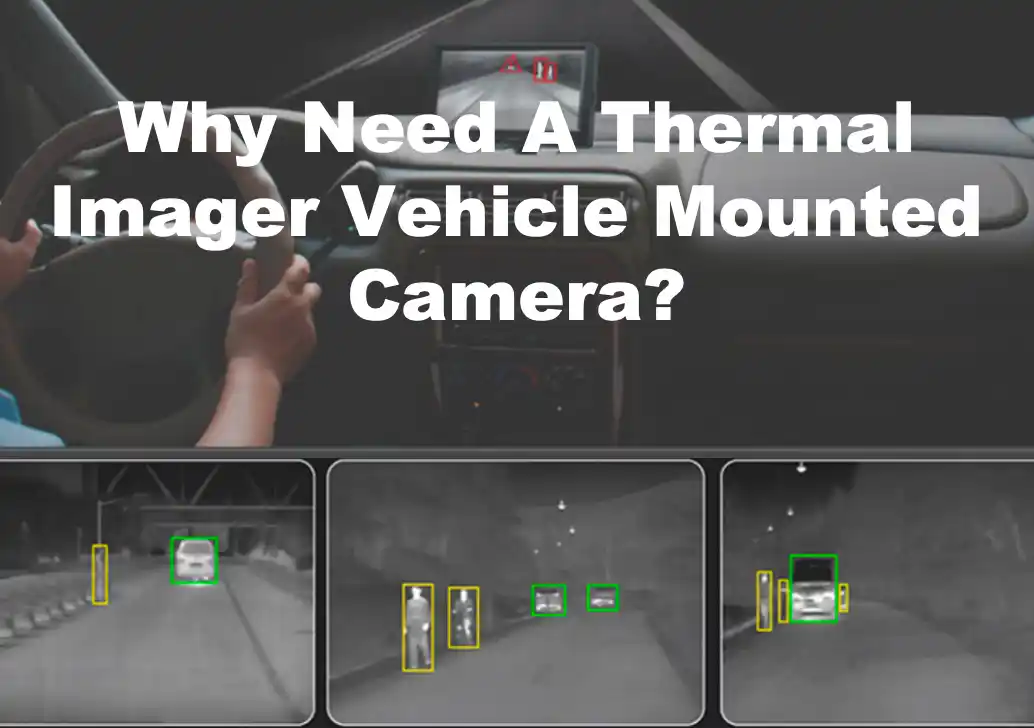Imagine driving in dense fog, heavy smog, or complete darkness. Is a standard camera sufficient? The answer is no. Standard cameras lack the ability to penetrate these conditions effectively. This is where a thermal imager vehicle-mounted camera becomes essential, playing a crucial role in enhancing your safety by providing clear visibility when you need it most.
What’s a Thermal Imager Vehicle Mounted Camera
A thermal imager vehicle-mounted camera is an advanced imaging device installed on a vehicle to enhance visibility by detecting and visualizing heat. Unlike standard cameras that rely on visible light, thermal imagers detect infrared radiation, which is emitted as heat by all objects. This technology enables the camera to generate images based on the temperature of objects, allowing drivers to see in complete darkness or challenging visibility conditions like fog, rain, smoke, or dust.

How Does the Thermal Imager Vehicle Mounted Camera Work?
Infrared Detection
Thermal cameras detect infrared radiation in the electromagnetic spectrum, specifically in the long-wave infrared range (around 8–14 micrometers). This wavelength is ideal for capturing and translating temperature differences into a visual image.
When installed on a vehicle, a thermal camera captures the heat signatures of various road objects, such as animals, humans, vehicles, or obstructions, regardless of lighting conditions.
Thermal Imaging Process
The camera’s sensor, often made from materials like vanadium oxide or amorphous silicon, captures the infrared radiation emitted from objects.
The sensor converts the thermal data into an electronic signal, which is processed and displayed as an image on the vehicle’s monitor.
Different colors or shades represent varying temperatures: warmer objects often appear brighter or in warmer colors (such as red or orange), while darker shades represent cooler areas.
Display on Monitor
The thermal image is displayed in real-time on a screen, showing objects as glowing forms based on their heat. This allows drivers to see beyond the limits of their headlights, identifying animals, pedestrians, or potential obstacles that may not be visible with traditional headlights or in adverse weather conditions.
Object Detection
Advanced thermal cameras include object-detection algorithms that can automatically highlight and alert drivers to potential hazards, such as humans or animals on the road.
The Advantages of a Thermal Imager Vehicle-Mounted Camera
A thermal imager vehicle-mounted camera offers numerous advantages, especially in enhancing safety during low visibility or poorly lit conditions. Below, we explore several key aspects, including dual spectrum integration, cost-effectiveness, anti-glare and smog penetration capabilities, superior penetrating power, and performance in rainy, foggy, nighttime, or glare environments.
1. Dual Spectrum Integrated
Dual spectrum integration refers to the capability of thermal imaging cameras to provide both thermal and visible light imaging. This dual-mode technology allows the camera to function effectively in both daytime and nighttime, as well as in conditions of bright light and low light.
Thermal Mode
This mode captures heat radiation, enabling the detection of pedestrians, animals, and obstacles even in complete darkness. It is especially useful for nighttime driving or in low-visibility scenarios.
Visible Light Mode
In normal lighting conditions, the visible light mode offers clear visual information. The combination of thermal and visible light images provides a comprehensive view, helping drivers identify targets more intuitively. This seamless transition between modes significantly enhances driver safety in various environments.

2. Cost-Effective
Thermal imaging technology has become more affordable due to advancements in technology and reductions in manufacturing costs. This cost-effectiveness is particularly advantageous in sectors where safety and efficiency are paramount.
- Thermal imaging cameras can help reduce the risk of nighttime driving accidents, thus lowering potential medical and repair costs.
- These devices allow for extended driving hours, enabling vehicles to operate normally in nighttime or adverse weather conditions, thereby increasing vehicle utilization.
- Compared to traditional night vision equipment, thermal cameras often have longer lifespans and require less maintenance, reducing long-term operational costs.
3. Anti-glare and Smog Penetration
Thermal imaging technology is designed to filter out glare, allowing clear imaging even when faced with oncoming headlights or other bright light sources. This feature ensures that drivers can clearly see the road and any obstacles, even in challenging lighting conditions. Additionally, thermal cameras can penetrate smoke and fog, providing reliable visual support in low-visibility situations.
Anti-Glare Functionality
While standard vehicle cameras may struggle with reflections and glare, thermal cameras maintain clarity by relying on heat radiation, thereby enhancing visibility for drivers.
Smog Penetration
Thermal cameras can effectively penetrate certain levels of fog and haze, providing clearer images and ensuring that road conditions can be monitored even in poor weather, enhancing safety.

4. Superior Penetrating Power
Thermal imaging cameras excel in penetrating power during adverse weather conditions, particularly in fog, rain, and darkness. Their ability to provide stable imaging support in various challenging environments sets them apart from traditional visible light cameras.
Rainy Conditions
Thermal cameras can detect heat sources even in heavy rain, ensuring that pedestrians and obstacles on the road are identified promptly.
Foggy Conditions
Unlike standard cameras, thermal imaging is less affected by fog, helping drivers recognize obstacles and hazards, thus reducing the risk of accidents.
Nighttime Use
Regardless of lighting conditions, thermal imaging cameras can clearly display heat sources, such as pedestrians and vehicles, providing essential safety during nighttime driving.
5. Exceptional Performance in Low Visibility and Low-Light Conditions
Thermal imaging cameras operate independently of visible light, making them particularly effective in low-visibility and low-light environments. For example, during nighttime or poorly lit stretches of road, drivers do not need to rely solely on traditional headlights; thermal cameras significantly enhance safety.
- In rural areas, unlit roads, or regions with limited lighting, thermal imaging cameras can ensure clear visibility of the surroundings, helping to prevent accidents.
- In blind spots where headlights may not reach, or in scenarios where light sources are obstructed, thermal imaging provides crucial information, enabling drivers to respond appropriately to sudden obstacles.
How to Pick The Right Thermal Imager Vehicle-Mounted Camera?
Choosing the right thermal imager vehicle-mounted camera depends on several key factors, such as the intended application, environmental conditions, budget, and specific technical features. Below are essential considerations to help you select a thermal camera that best meets your needs.
1. Application and Use Case
Consider where and how you will use the thermal camera. Different industries and scenarios have distinct requirements:
a. Mining, Construction, and Industrial Sites
For rugged conditions, prioritize durability and resistance to dust, moisture, and impact. Cameras with high penetration capabilities for fog, dust, and smoke may be essential.
b. Law Enforcement and Security
Opt for cameras with a wide field of view, real-time monitoring, and high-resolution imaging to identify potential threats or track targets effectively.
c. Search and Rescue
Choose cameras with excellent low-light performance and long-range detection to locate individuals or hazards in challenging conditions.
d. Commercial Vehicles
For general nighttime driving and obstacle detection, cameras with anti-glare, and high visibility in darkness or fog are suitable.
2. Resolution and Image Quality
Resolution affects the clarity and detail of the thermal image. Higher-resolution cameras provide better image quality, which can be crucial for detecting smaller objects or identifying details in complex environments.
3. Field of View (FOV)
The field of view determines how much of the area in front or around the vehicle the camera can capture.
Wide FOV: Provides better situational awareness, covering a broader area at the expense of distance detail. It is ideal for general driving, urban areas, and close-range detection.
Narrow FOV: Offers a narrower but more focused view, allowing for better detection at longer distances. This is suitable for applications where long-range visibility is prioritized, such as rural or highway driving.
4. Detection Range
Detection range is essential for assessing the camera’s ability to capture objects at different distances.
a. Short Range (within 100 meters): Sufficient for most urban driving and obstacle detection.
b. Medium Range (100–300 meters): Useful for rural driving or industrial sites, where detecting hazards at mid-range is essential.
c. Long Range (300 meters or more): Required for high-speed driving, military, and security applications where distant detection is necessary.
5. Dual Spectrum Capability
Dual spectrum capability combines thermal imaging with a standard optical (visible light) camera. This feature allows you to switch between thermal and visible light views or overlay them for enhanced detail.
6. Anti-Glare and Penetration Capabilities
Anti-glare and penetration capabilities are important for clear imaging in harsh conditions.
a. Anti-Glare
Reduces interference from headlights and other bright light sources, crucial for nighttime and urban driving.
b. Fog and Smoke Penetration
Enhances the camera’s performance in foggy, smoky, or dusty environments, which is essential for mining, industrial, and rescue applications.
7. Durability and Environmental Resistance
Thermal cameras used in outdoor or industrial environments need to withstand harsh conditions. Look for cameras with the following features:
a. Weatherproofing
Cameras with IP ratings (e.g., IP66 or IP67) offer protection against dust and water, essential for mining, construction, or rugged environments.
b. Shock and Vibration Resistance
For off-road and industrial vehicles, shock-resistant cameras can withstand rough handling and bumpy terrain.
8. Integration and Compatibility
Cameras that integrate well with existing vehicle systems and displays are easier to use and reduce driver distraction.
9. Budget and Cost-Effectiveness
Thermal cameras can range significantly in price depending on resolution, features, and durability. Define your budget and prioritize features that offer the best value for your application. While higher-resolution and dual-spectrum cameras come at a premium, they may provide greater operational efficiency and safety benefits in the long run.
Conclusión
Before choosing a thermal infrared camera, it's essential to understand how it works and how to select the right one. We hope the article above has provided you with a comprehensive overview. If you're looking for an infrared thermal camera, VST is the ideal choice. VST specializes in vehicle safety solutions, offering a range of products including AI cameras, infrared thermal cameras, 360-degree camera systems, BSD camera systems, and more.


